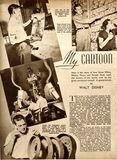
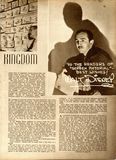
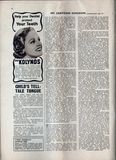
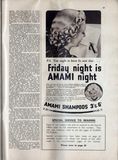
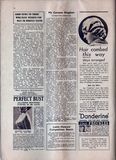
Here is the story of how Snow White, Mickey Mouse and Donald Duck reach the screens of the world, told by the great cartoonist himself. A special article by WALT DISNEY
[image]Left, on of the scores of artists who are engaged in painting water colour backgrounds[/image]
[image]Right, Disney’s story men at work on the board which carries sketches of the main incidents of a cartoon in the making[/image]
[image]Above, the Multiplane camera which cost 15,000 to perfect. Below, 3 sound effects expert reproducing the "bongs" of a grandfather clock, by tapping old brake drums![/image]
THE world of the animated cartoon is the world of our imagination, a world in which the sun and the moon and the stars and every living thing obey our commands. We pluck a little character from our imagination, and if he becomes disobedient we liquidate him with an eraser. No dictator has power half so absolute. Our materials are anything which the brain can imagine and the hands can draw – all human experience: the real world and dream worlds, colour, music, sound, and, above all, motion. A fascinating business, but to explain it we must talk of registering pins and exposure sheets, frames and layouts, basic tempos and sweatbox sessions, acoustical beats and audio-frequency oscillators. It is all very technical and confusing to a layman. Often we spend an afternoon showing visitors how cartoons are made, and at the end they timidly inquire: "But what makes the little drawings move ?"
Well, as a matter of fact, all motion on the screen is just an illusion. When a motion-picture camera shoots a scene, it breaks the action into a series of still photographs, showing progressive stages of that action. When these photographs are projected on a screen, at the rate of sixteen hundred a minute, the illusion of motion results. This is because the eye-brain combination cannot register the images as fast as we can project them an a screen, so it overlaps them and the illusion of motion results. This persistence of vision was discovered by Peter Mark Roget in 1826. The same principle explains why our drawn figures seem to move. We make a series of drawings showing the progressive stages of action. Then we photograph these on regulation motion-picture film and project them on to a screen. Think of the "flip" books of your childhood, when you thumbed the pages of a pad of drawings and the pages whisked from cover to cover: the persistence of vision.
The early history of the animated cartoon was one of gradual but slow development. Many series thrived and died. All were unbelievably crude compared to present standards. As a form of art and entertainment, cartoons had no prestige. They were turned out with a minimum of time, money and thought. Distributors gave them away as premiums to exhibitors purchasing features. The average cost was around two or three thousand dollars. To-day we sometimes spend eighty thousand dollars for a seven-minute picture.
[…]